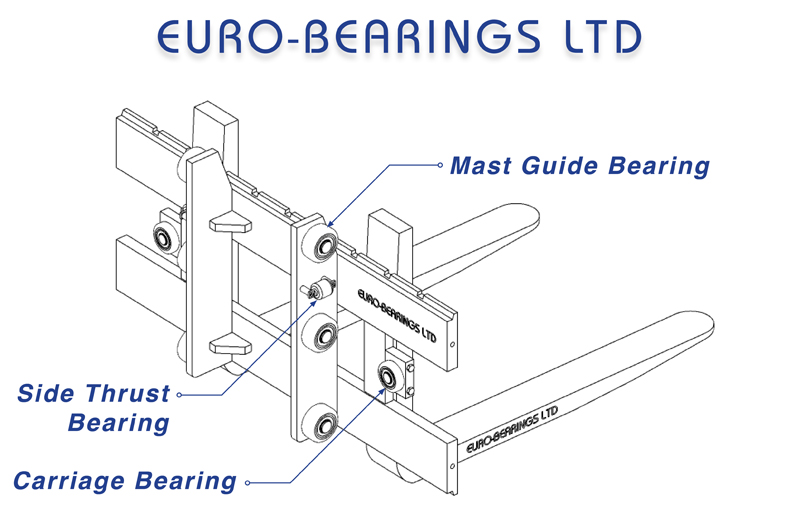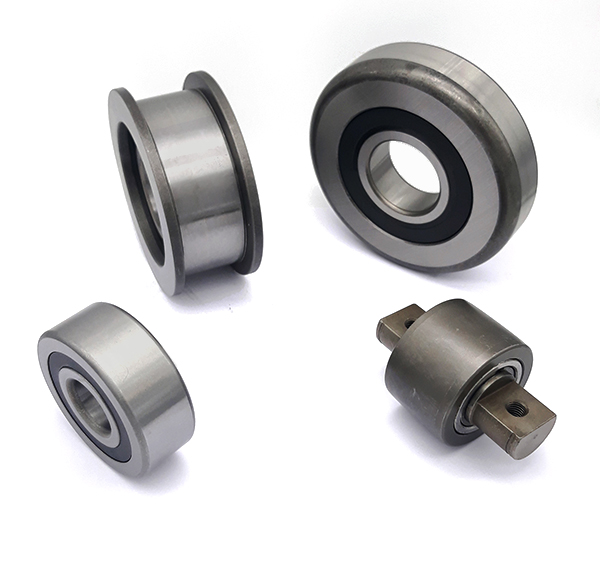Mast bearings are found on fork lift trucks. They carry the forks (carriage) up the mast and they also enable the various stages of the mast to extend.
There are four main types of Mast Bearings:
- Mast guide bearings – these bearings guide the mast stages up as the forks are raised beyond the first stage. They also attach the fork carriage to the mast rails.
- Carriage bearings – these provide lateral guidance to the fork carriage as it travels up the mast. They are typically smaller than the mast guide bearings.
- Side thrust rollers – these bearings transfer the lateral (sideways) loads to the mast and help to prevent twist. Typically they are mounted on a shaft (pin).
- Chain roller bearings – these guide the leaf chain that raises & lowers the mast. The bearings are usually flanged like a pulley to ensure the chain is captive.
Sometimes the mast guide bearings and side thrust rollers are fitted as a complete assembly, known as a Combined Roller Bearing.

What features do Mast Bearings have?
- Thick Outer Ring: Mast bearings operate at relatively low speeds. They travel along the rail as a track bearing (like a wheel) and consequently experience high loads. The outer ring (steel tyre) of a mast bearing is much thicker than a standard bearing, to enable this load to be transmitted.
- Inseparable Design: The components of the bearings are held together to form an inseparable ‘wheel’.
- Balls or Rollers: Due to the high loads, mast bearings usually have balls or rollers as their rolling element.
- Seals: Mast bearings are usually to sealed to prevent the grease from escaping and to keep debris out. The seal can be rubber (RS) or metal (ZZ), or sometimes a combination of both (ZRS).
How to Identify a Mast Bearing?
Our Technical Sales team are very experienced in identifying mast bearings. To help them, you will need to provide the following information:
- Make of the fork truck (e.g. Toyota)
- Part numbers or brands stamped on the bearing, or a part number from the parts book. Everything helps.
- The dimensions as accurately as possible. That is the ID (shaft size), OD (outside diameter) & width. The width of the outer ring and the inner ring are likely to be different. It is important to know both to ensure the bearing will fit back on the shaft. For side thrust rollers, the length of the shaft and the hole centres is also critical.
- The shape of the bearing & whether is has rollers or balls inside. Choose the nearest type from our drawing list or send us some photos.

(Clockwise from back left: Chain Roller Bearing, Mast Guide Bearing, Side Thrust Roller & Carriage Bearing)
Oversize or Custom Mast Bearings
If the bearing you need is no longer in production or you have a special requirement, Euro-Bearings Ltd can manufacture bespoke mast bearings to suit your needs. Typically we would need a sample or pattern to quote and lead times can be as short as 24 hours.
Contact Us
If you need help to identify a mast bearing or want a quotation, please contact our technical sales team by email or telephone.
